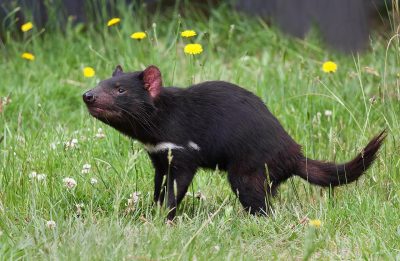Tasmanian Devils Devastate Penguin Population on Australian Island

All Global Research articles can be read in 51 languages by activating the “Translate Website” drop down menu on the top banner of our home page (Desktop version).
Visit and follow us on Instagram at @crg_globalresearch.
***
In an attempt to protect the dwindling numbers of Tasmanian devils, an “insurance population” was shipped to Maria Island causing “catastrophic” damage to the native birdlife, including the elimination of little penguins on the small Australian island.
“Every time humans have deliberately or accidentally introduced mammals to oceanic islands, there’s always been the same outcome … a catastrophic impact on one or more bird species,” Dr. Eric Woehler, the convener of BirdLife Tasmania said to The Guardian.
The population of little penguins has declined since the Tasmanian devils were introduced in 2012, but according to a report by BirdLife Tasmania, the most recent survey showed that the penguins were completely gone from the island, according to The Guardian.
The Tasmanian devils were moved to the island because of the threat of the highly contagious and deadly devil facial tumor disease.
The initial population of Tasmanian devils was 28 in 2012 but has since grown to around 100 devils as of 2016.
Just a decade ago, the 45 square mile island was the home to around 3,000 breeding pairs of little penguins.

Little penguins are the smallest of all the penguin species.BirdLife Tasmania / Eric Woehler
“Losing 3,000 pairs of penguins from an island that is a national park that should be a refuge for this species basically is a major blow,” Woehler said to The Guardian.
Before the species were introduced to the island, a 2011 report by the Tasmanian Department of Primary Industries, Parks, and Environment predicted that introducing the carnivorous species would have “a negative impact on little penguin and shearwater colonies on Maria Island through devil predation,” according to The Guardian.
In addition to little penguins, researchers also found that Tasmanian devils had also destroyed colonies of short-tailed shearwaters on the Australian island. Wombats and possums are also prey to the devils, according to The Hill.
“Because of their larger size and ability to dig, devils had greater impacts on nesting shearwaters than either cats or possums [which also prey on the birds],” the study found.
Woehler noted that the devils impacted another bird species on the island: Cape Barren geese. The species are ground-nesting birds, but they’ve been nesting in trees to avoid the Tasmanian devils, he said.
The decision to bring the Tasmanian devils to the island a decade ago was sound according to Woehler because, at that time, the facial tumor disease was not well understood, according to The Guardian.
However, in 2020, researchers found that the facial tumor disease was unlikely to wipe out the population of Tasmanian devils.
The Save the Tasmanian Devil program’s government spokesperson said that the program is continually monitored, according to The Independent.
“All effective conservation programs are adaptive and the STDP will continue to evolve in line with new knowledge in science and emerging priorities,” the spokesperson said to The Guardian. “This also applies to Maria Island, where active monitoring and management occurs, and Maria Island remains an important part of the broader devil program to help restore and maintain an enduring and resilient wild devil population in Tasmania.”
Woehler said, “it’s rather hard to justify” keeping the Tasmanian devils on the island because of the new research on the facial disease. He said that it’s likely the penguins will return once the devils are removed from the island, according to RT News.
*
Note to readers: Please click the share buttons above or below. Follow us on Instagram, @crg_globalresearch. Forward this article to your email lists. Crosspost on your blog site, internet forums. etc.
Audrey Nakagawa is the content creator intern at EcoWatch. She is a senior at James Madison University studying Media, Art, and Design, with a concentration in journalism. She’s a reporter for The Breeze in the culture section and writes features on Harrisonburg artists, album reviews, and topics related to mental health and the environment. She was also a contributor for Virginia Reports where she reported on the impact that COVID-19 had on college students.
Featured image: A Tasmanian devil (CC BY-SA 3.0)

